Panasonic ZS70 vs FZ80
The Panasonic Lumix DC-ZS70 (called Panasonic TZ90 in some regions) and the Panasonic Lumix DC-FZ80 (labelled Panasonic FZ82 in some countries) are two digital cameras that were revealed to the public, respectively, in April 2017 and January 2017. Both the ZS70 and the FZ80 are fixed lens compact cameras that are equipped with a 1/2.3-inch sensor. The ZS70 has a resolution of 20.2 megapixels, whereas the FZ80 provides 18 MP.
Below is an overview of the main specs of the two cameras as a starting point for the comparison.

Check ZS70 offers at
ebay.com

Check FZ80 offers at
ebay.com
Going beyond this snapshot of core features and characteristics, what are the differences between the Panasonic Lumix DC-ZS70 and the Panasonic Lumix DC-FZ80? Which one should you buy? Read on to find out how these two cameras compare with respect to their body size, their imaging sensors, their shooting features, their input-output connections, and their reception by expert reviewers.
Body comparison
The physical size and weight of the Panasonic ZS70 and the Panasonic FZ80 are illustrated in the side-by-side display below. The two cameras are presented according to their relative size. Three successive views from the front, the top, and the rear are shown. All width, height and depth dimensions are rounded to the nearest millimeter.
The ZS70 can be obtained in two different colors (black, silver), while the FZ80 is only available in black.
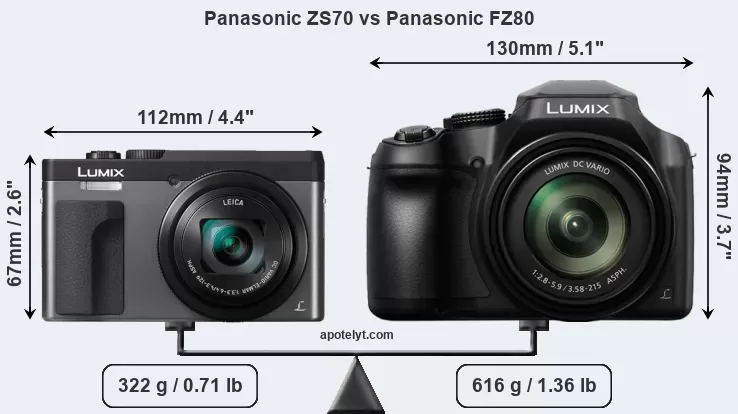
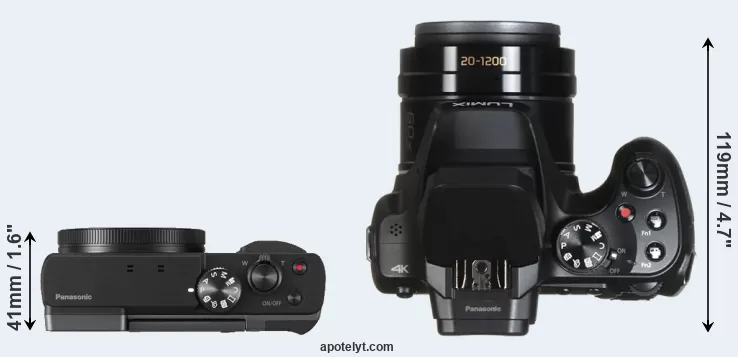
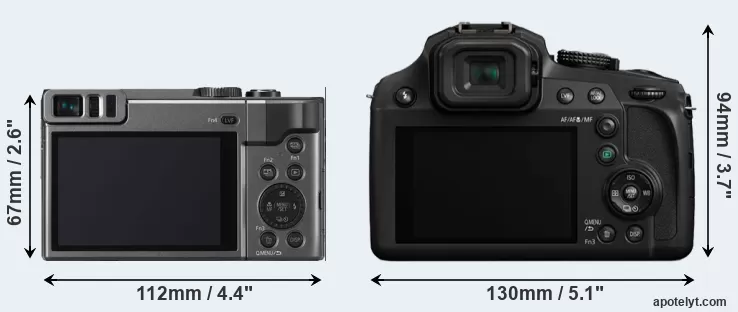
If the front view area (width x height) of the cameras is taken as an aggregate measure of their size, the Panasonic FZ80 is considerably larger (63 percent) than the Panasonic ZS70. Moreover, the FZ80 is substantially heavier (91 percent) than the ZS70. In this context, it is worth noting that neither the ZS70 nor the FZ80 are weather-sealed.
Concerning battery life, the ZS70 gets 380 shots out of its Panasonic DMW-BLG10 battery, while the FZ80 can take 330 images on a single charge of its Panasonic DMW-BMB9 power pack. The battery packs of both cameras can be charged via USB, which can be very convenient when travelling.
The following table provides a synthesis of the main physical specifications of the two cameras and other similar ones. If you would like to visualize and compare a different camera combination, you can navigate to the CAM-parator app and make your selection from a broad list of cameras there.

| # | Camera Model |
Camera Width |
Camera Height |
Camera Depth |
Camera Weight |
Battery Life |
Weather Sealing |
Camera Launch |
Launch Price (USD) |
Street Price |
|
|---|---|---|---|---|---|---|---|---|---|---|---|
| 1. | Panasonic ZS70 | 112 mm | 67 mm | 41 mm | 322 g | 380 | n | Apr 2017 | 449 | ebay.com | |
| 2. | Panasonic FZ80 | 130 mm | 94 mm | 119 mm | 616 g | 330 | n | Jan 2017 | 399 | ebay.com | |
| 3. | Canon SX740 | 110 mm | 64 mm | 40 mm | 299 g | 265 | n | Jul 2018 | 399 | amazon.com | |
| 4. | Canon SX730 | 110 mm | 64 mm | 40 mm | 300 g | 250 | n | Apr 2017 | 399 | ebay.com | |
| 5. | Canon SX720 | 110 mm | 64 mm | 36 mm | 270 g | 250 | n | Feb 2016 | 379 | ebay.com | |
| 6. | Fujifilm XF10 | 113 mm | 64 mm | 41 mm | 279 g | 330 | n | Jul 2018 | 499 | ebay.com | |
| 7. | Kodak AZ901 | 139 mm | 104 mm | 119 mm | 777 g | 400 | n | Jan 2016 | 499 | amazon.com | |
| 8. | Panasonic ZS80 | 112 mm | 69 mm | 42 mm | 327 g | 380 | n | Feb 2019 | 449 | ebay.com | |
| 9. | Panasonic TS7 | 117 mm | 76 mm | 37 mm | 319 g | 300 | Y | May 2018 | 449 | ebay.com | |
| 10. | Panasonic FZ150 | 124 mm | 82 mm | 92 mm | 528 g | 410 | n | Aug 2011 | 499 | ebay.com | |
| 11. | Panasonic LX5 | 110 mm | 65 mm | 43 mm | 271 g | 400 | n | Jul 2010 | 499 | ebay.com | |
| 12. | Sony HX350 | 130 mm | 93 mm | 103 mm | 652 g | 300 | n | Dec 2016 | 449 | ebay.com | |
| Note: Measurements and pricing do not include easily detachable parts, such as add-on or interchangeable lenses or optional viewfinders. | |||||||||||
The price is, of course, an important factor in any camera decision. The listed launch prices provide an indication of the market segment that the manufacturer of the cameras have been targeting. The FZ80 was launched at a somewhat lower price (by 11 percent) than the ZS70, which makes it more attractive for photographers on a tight budget. Usually, retail prices stay at first close to the launch price, but after several months, discounts become available. Later in the product cycle and, in particular, when the replacement model is about to appear, further discounting and stock clearance sales often push the camera price considerably down.
Sensor comparison
The imaging sensor is at the core of digital cameras and its size is one of the main determining factors of image quality. A large sensor will generally have larger individual pixels that offer better low-light sensitivity, provide wider dynamic range, and have richer color-depth than smaller pixels in a sensor of the same technological generation. Further, a large sensor camera will give the photographer additional creative options when using shallow depth-of-field to isolate a subject from its background. On the downside, larger sensors tend to be associated with larger, more expensive camera bodies and lenses.
Both cameras under consideration feature a 1/2.3-inch sensor and have a format factor (sometimes also referred to as "crop factor") of 5.6. Within the spectrum of camera sensors, this places the review cameras among the smaller-sensor digicams that favor affordability and compact design. Both cameras feature a native aspect ratio (sensor width to sensor height) of 4:3.
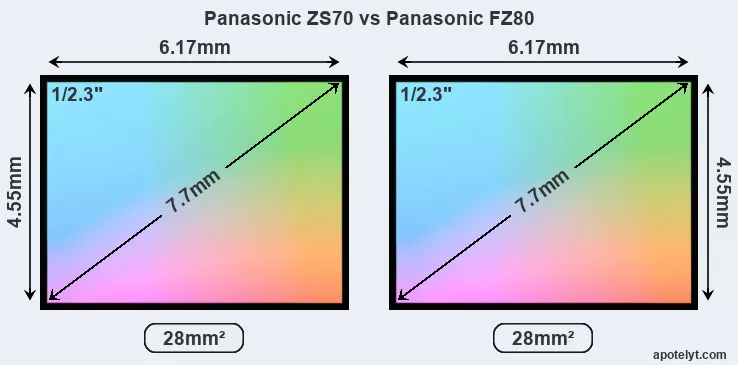
While the two cameras under review share the same sensor size, the ZS70 offers a higher resolution of 20.2 megapixels, compared with 18 MP of the FZ80. This megapixels advantage translates into a 6 percent gain in linear resolution. On the other hand, these sensor specs imply that the ZS70 has a higher pixel density and a smaller size of the individual pixel (with a pixel pitch of 1.18μm versus 1.25μm for the FZ80). In this context, it should be noted, however, that the ZS70 is a somewhat more recent model (by 3 months) than the FZ80, and its sensor might have benefitted from technological advances during this time that at least partly compensate for the smaller pixel size. Coming back to sensor resolution, it should be mentioned that neither of the two cameras has an anti-alias filter installed, so they are able to capture all the detail the sensor resolves.
The resolution advantage of the Panasonic ZS70 implies greater flexibility for cropping images or the possibility to print larger pictures. The maximum print size of the ZS70 for good quality output (200 dots per inch) amounts to 25.9 x 19.4 inches or 65.8 x 49.4 cm, for very good quality (250 dpi) 20.7 x 15.6 inches or 52.7 x 39.5 cm, and for excellent quality (300 dpi) 17.3 x 13 inches or 43.9 x 32.9 cm. The corresponding values for the Panasonic FZ80 are 24.5 x 18.4 inches or 62.2 x 46.6 cm for good quality, 19.6 x 14.7 inches or 49.7 x 37.3 cm for very good quality, and 16.3 x 12.2 inches or 41.5 x 31.1 cm for excellent quality prints.
The Panasonic Lumix DC-ZS70 has a native sensitivity range from ISO 80 to ISO 3200, which can be extended to ISO 80-6400. The Panasonic Lumix DC-FZ80 offers exactly the same ISO settings.
Technology-wise, both cameras are equipped with BSI-CMOS (Backside Illuminated Complementary Metal–Oxide–Semiconductor) sensors. Both cameras use a Bayer filter for capturing RGB colors on a square grid of photosensors. This arrangement is found in most digital cameras.
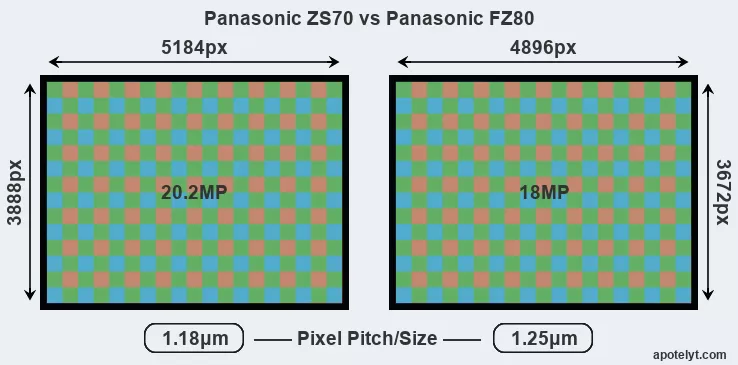
For many cameras, data on sensor performance has been reported by DXO Mark. This service determines an overall sensor rating, as well as sub-scores for low-light sensitivity ("DXO Sports"), dynamic range ("DXO Landscape"), and color depth ("DXO Portrait"). The following table provides an overview of the physical sensor characteristics, as well as the sensor quality measurements for a selection of comparators.

| # | Camera Model |
Sensor Class |
Resolution (MP) |
Horiz. Pixels |
Vert. Pixels |
Video Format |
DXO Portrait |
DXO Landscape |
DXO Sports |
DXO Overall |
|
|---|---|---|---|---|---|---|---|---|---|---|---|
| 1. | Panasonic ZS70 | 1/2.3 | 20.2 | 5184 | 3888 | 4K/30p | 19.1 | 10.6 | 106 | 36 | |
| 2. | Panasonic FZ80 | 1/2.3 | 18.0 | 4896 | 3672 | 4K/30p | 20.5 | 11.9 | 900 | 49 | |
| 3. | Canon SX740 | 1/2.3 | 20.2 | 5184 | 3888 | 4K/30p | 20.6 | 12.1 | 1050 | 51 | |
| 4. | Canon SX730 | 1/2.3 | 20.2 | 5184 | 3888 | 1080/60p | 20.5 | 11.9 | 924 | 50 | |
| 5. | Canon SX720 | 1/2.3 | 20.2 | 5184 | 3888 | 1080/60p | 20.3 | 11.8 | 817 | 48 | |
| 6. | Fujifilm XF10 | APS-C | 24.0 | 6000 | 4000 | 4K/15p | 24.0 | 13.4 | 1844 | 83 | |
| 7. | Kodak AZ901 | 1/2.3 | 20.2 | 5184 | 3888 | 1080/30p | 20.3 | 11.7 | 806 | 48 | |
| 8. | Panasonic ZS80 | 1/2.3 | 20.2 | 5184 | 3888 | 4K/30p | 20.7 | 12.2 | 1103 | 52 | |
| 9. | Panasonic TS7 | 1/2.3 | 20.2 | 5184 | 3888 | 4K/30p | 20.6 | 12.1 | 1028 | 51 | |
| 10. | Panasonic FZ150 | 1/2.3 | 12.0 | 4000 | 3000 | 1080/60p | 19.4 | 10.9 | 132 | 40 | |
| 11. | Panasonic LX5 | 1/1.7 | 10.0 | 3648 | 2736 | 720/60p | 19.6 | 10.8 | 132 | 41 | |
| 12. | Sony HX350 | 1/2.3 | 19.9 | 5152 | 3864 | 1080/60p | 20.5 | 11.9 | 896 | 49 | |
| Note: DXO values in italics represent estimates based on sensor size and age. | |||||||||||
Many modern cameras cannot only take still pictures, but also record videos. Both cameras under consideration are equipped with sensors that have a sufficiently high read-out speed for moving images, and both provide the same movie specifications (4K/30p).
Feature comparison
Apart from body and sensor, cameras can and do differ across a variety of features. The ZS70 and the FZ80 are similar in the sense that both feature an electronic viewfinder, which is helpful when framing images in bright sunlight. Moreover, their viewfinders offer an identical resolution of 1166k dots. The following table reports on some other key feature differences and similarities of the Panasonic ZS70, the Panasonic FZ80, and comparable cameras.

| # | Camera Model |
Viewfinder (Type or 000 dots) |
Control Panel (yes/no) |
LCD Specifications (inch/000 dots) |
LCD Attach- ment |
Touch Screen (yes/no) |
Max Shutter Speed * |
Max Shutter Flaps * |
Built-in Flash (yes/no) |
Built-in Image Stab |
|
|---|---|---|---|---|---|---|---|---|---|---|---|
| 1. | Panasonic ZS70 | 1166 | n | 3.0 / 1040 | tilting | Y | 1/2000s | 10.0/s | Y | Y | |
| 2. | Panasonic FZ80 | 1166 | n | 3.0 / 1040 | fixed | Y | 1/2000s | 10.0/s | Y | Y | |
| 3. | Canon SX740 | none | n | 3.0 / 922 | tilting | n | 1/3200s | 10.0/s | Y | Y | |
| 4. | Canon SX730 | none | n | 3.0 / 922 | tilting | n | 1/3200s | 5.9/s | Y | Y | |
| 5. | Canon SX720 | none | n | 3.0 / 922 | fixed | n | 1/3200s | 5.9/s | Y | Y | |
| 6. | Fujifilm XF10 | none | n | 3.0 / 1040 | fixed | Y | 1/4000s | 6.0/s | Y | n | |
| 7. | Kodak AZ901 | 202 | n | 3.0 / 920 | swivel | n | 1/2000s | 5.0/s | Y | Y | |
| 8. | Panasonic ZS80 | 2330 | n | 3.0 / 1040 | tilting | Y | 1/2000s | 10.0/s | Y | Y | |
| 9. | Panasonic TS7 | 1170 | n | 3.0 / 1040 | fixed | n | 1/1300s | 10.0/s | Y | Y | |
| 10. | Panasonic FZ150 | 202 | n | 3.0 / 460 | swivel | n | 1/2000s | 12.0/s | Y | Y | |
| 11. | Panasonic LX5 | optional | n | 3.0 / 460 | fixed | n | 1/4000s | 2.5/s | Y | Y | |
| 12. | Sony HX350 | 202 | n | 3.0 / 922 | tilting | n | 1/4000s | 10.0/s | Y | Y | |
| Note: *) Information refers to the mechanical shutter, unless the camera only has an electronic one. | |||||||||||
The reported shutter speed information refers to the use of the mechanical shutter. Yet, some cameras only have an electronic shutter, while others have an electronic shutter in addition to a mechanical one. In fact, both cameras under consideration feature an electronic shutter, which makes completely silent shooting possible. However, this mode is less suitable for photographing moving objects (risk of rolling shutter) or shooting under artificial light sources (risk of flickering).
Both the ZS70 and the FZ80 have zoom lenses built in. The ZS70 has a 24-720mm f/3.3-6.4 optic and the FZ80 offers a 20-1200mm f/2.8-5.9 (focal lengths in full frame equivalent terms). Hence, the FZ80 provides a wider angle of view at the short end, as well as more tele-photo reach at the long end than the ZS70. The FZ80 offers the faster maximum aperture.
Concerning the storage of imaging data, both the ZS70 and the FZ80 write their files to SDXC cards. Both cameras can use UHS-I cards, which provide for Ultra High Speed data transfer of up to 104 MB/s.
Connectivity comparison
For some imaging applications, the extent to which a camera can communicate with its environment can be an important aspect in the camera decision process. The table below provides an overview of the connectivity of the Panasonic Lumix DC-ZS70 and Panasonic Lumix DC-FZ80 and, in particular, the interfaces the cameras (and selected comparators) provide for accessory control and data transfer.

| # | Camera Model |
Hotshoe Port |
Internal Mic / Speaker |
Microphone Port |
Headphone Port |
HDMI Port |
USB Port |
WiFi Support |
NFC Support |
Bluetooth Support |
|
|---|---|---|---|---|---|---|---|---|---|---|---|
| 1. | Panasonic ZS70 | - | stereo / mono | - | - | micro | 2.0 | Y | - | - | |
| 2. | Panasonic FZ80 | Y | stereo / mono | - | - | micro | 2.0 | Y | - | - | |
| 3. | Canon SX740 | - | stereo / mono | - | - | micro | 2.0 | Y | - | Y | |
| 4. | Canon SX730 | - | stereo / mono | - | - | micro | 2.0 | Y | Y | Y | |
| 5. | Canon SX720 | - | stereo / mono | - | - | micro | 2.0 | Y | Y | - | |
| 6. | Fujifilm XF10 | - | stereo / mono | Y | - | micro | 2.0 | Y | - | Y | |
| 7. | Kodak AZ901 | - | stereo / mono | - | - | micro | 2.0 | Y | - | - | |
| 8. | Panasonic ZS80 | - | stereo / mono | - | - | micro | 2.0 | Y | - | Y | |
| 9. | Panasonic TS7 | - | stereo / mono | - | - | micro | 2.0 | Y | - | - | |
| 10. | Panasonic FZ150 | Y | stereo / - | - | - | mini | 2.0 | - | - | - | |
| 11. | Panasonic LX5 | Y | mono / mono | - | - | mini | 2.0 | - | - | - | |
| 12. | Sony HX350 | - | stereo / mono | - | - | micro | 2.0 | - | - | - |
It is notable that the FZ80 has a hotshoe, which makes it possible to easily attach optional accessories, such as an external flash gun. The ZS70 does not feature such an accessory-socket.
Both the ZS70 and the FZ80 have been discontinued, but can regularly be found used on ebay. The ZS70 was replaced by the Panasonic ZS80, while the FZ80 does not have a direct successor. Further information on the features and operation of the ZS70 and FZ80 can be found, respectively, in the Panasonic ZS70 Manual (free pdf) or the online Panasonic FZ80 Manual.
Review summary
So what conclusions can be drawn? Which of the two cameras – the Panasonic ZS70 or the Panasonic FZ80 – has the upper hand? Is one clearly better than the other? Below is a summary of the relative strengths of each of the two contestants.
Arguments in favor of the Panasonic Lumix DC-ZS70:
- More detail: Offers more megapixels (20.2 vs 18MP) with a 6% higher linear resolution.
- More flexible LCD: Has a tilting screen for odd-angle shots in landscape orientation.
- More selfie-friendly: Has an articulated screen that can be turned to be front-facing.
- More compact: Is smaller (112x67mm vs 130x94mm) and thus needs less room in the bag.
- Less heavy: Is lighter (by 294g or 48 percent) and hence easier to carry around.
- Longer lasting: Can take more shots (380 versus 330) on a single battery charge.
- More modern: Is somewhat more recent (announced 3 months after the FZ80).
Reasons to prefer the Panasonic Lumix DC-FZ80:
- Better light gathering: Has a lens with a wider maximum aperture (f/2.8 vs f/3.3).
- Wider view: Has a wider-angle lens that facilitates landscape or interior shots.
- More tele-reach: Has a longer tele-lens for perspective compression and subject magnification.
- Better lighting: Features a hotshoe and can thus hold and trigger an external flash gun.
- More affordable: Was released into a lower priced segment (11 percent cheaper at launch).
- More heavily discounted: Has been on the market for longer (launched in January 2017).
If the count of relative strengths (bullet points above) is taken as a measure, the ZS70 comes out slightly ahead of the FZ80 (7 : 6 points). However, the relative importance of the various individual camera aspects will vary according to personal preferences and needs, so that you might like to apply corresponding weights to the particular features before making a decision on a new camera. A professional wedding photographer will view the differences between cameras in a way that diverges from the perspective of a travel photog, and a person interested in cityscapes has distinct needs from a macro shooter. Hence, the decision which camera is best and worth buying is often a very personal one.
How about other alternatives? Do the specifications of the Panasonic ZS70 and the Panasonic FZ80 place the cameras among the top in their class? Find out in the latest Best Superzoom Camera listing whether the two cameras rank among the cream of the crop.
In any case, while the comparison of the spec-sheets of cameras can offer a general idea of their imaging potential, it remains incomplete and does no justice, for example, to the way the ZS70 or the FZ80 perform in practice. User reviews that are available, for instance, at amazon can sometimes shed light on these issues, but such feedback is all too often partial, inconsistent, and inaccurate.
Expert reviews
This is where reviews by experts come in. The following table reports the overall ratings of the cameras as published by some of the major camera review sites (amateurphotographer [AP], cameralabs [CL], digitalcameraworld [DCW], dpreview [DPR], ephotozine [EPZ], photographyblog [PB]). As can be seen, the professional reviewers agree in many cases on the quality of different cameras, but sometimes their assessments diverge, reinforcing the earlier point that a camera decision is often a very personal choice.

| # | Camera Model |
AP score |
CL score |
DCW score |
DPR score |
EPZ score |
PB score |
Camera Launch |
Launch Price (USD) |
Street Price |
|
|---|---|---|---|---|---|---|---|---|---|---|---|
| 1. | Panasonic ZS70 | .. | + + | .. | .. | 4/5 | 4/5 | Apr 2017 | 449 | ebay.com | |
| 2. | Panasonic FZ80 | .. | + + | .. | .. | 4.5/5 | 4.5/5 | Jan 2017 | 399 | ebay.com | |
| 3. | Canon SX740 | .. | + | 3.5/5 | .. | 4/5 | 4/5 | Jul 2018 | 399 | amazon.com | |
| 4. | Canon SX730 | .. | + | .. | .. | 4/5 | 4/5 | Apr 2017 | 399 | ebay.com | |
| 5. | Canon SX720 | .. | + | .. | .. | 4/5 | 4.5/5 | Feb 2016 | 379 | ebay.com | |
| 6. | Fujifilm XF10 | .. | .. | 4/5 | 75/100 | 4/5 | 4.5/5 | Jul 2018 | 499 | ebay.com | |
| 7. | Kodak AZ901 | .. | .. | .. | .. | 3.5/5 | 3/5 | Jan 2016 | 499 | amazon.com | |
| 8. | Panasonic ZS80 | .. | + + | .. | .. | 4.5/5 | .. | Feb 2019 | 449 | ebay.com | |
| 9. | Panasonic TS7 | .. | + | .. | .. | .. | 3.5/5 | May 2018 | 449 | ebay.com | |
| 10. | Panasonic FZ150 | 3/5 | + + | .. | 76/100 | 4/5 | 4.5/5 | Aug 2011 | 499 | ebay.com | |
| 11. | Panasonic LX5 | 4/5 | + | .. | 73/100 | 4.5/5 | 4.5/5 | Jul 2010 | 499 | ebay.com | |
| 12. | Sony HX350 | .. | .. | .. | .. | .. | 4/5 | Dec 2016 | 449 | ebay.com | |
| Note: (+ +) highly recommended; (+) recommended; (o) reviewed; (..) not available. | |||||||||||
The above review scores should be interpreted with care, though. The ratings were established in reference to similarly priced cameras that were available in the market at the time of the review. Hence, a score should always be seen in the context of the camera's market launch date and its price, and rating-comparisons among cameras that span long time periods or concern very differently equipped models make little sense. Also, kindly note that some of the listed sites have over time developped their review approaches and their reporting style.

Check ZS70 offers at
ebay.com

Check FZ80 offers at
ebay.com
Other camera comparisons
Did this review help to inform your camera decision process? In case you would like to check on the differences and similarities of other camera models, just use the search menu below. Alternatively, you can follow any of the listed hyperlinks for comparisons that others found interesting.
- Fujifilm X100S vs Panasonic ZS70
- Leica Q2 vs Panasonic ZS70
- Leica S Typ 006 vs Panasonic ZS70
- Olympus Stylus 1 vs Panasonic FZ80
- Panasonic FZ80 vs Panasonic GX8
- Panasonic FZ80 vs Panasonic GX9
- Panasonic FZ80 vs Panasonic ZS80
- Panasonic FZ80 vs Sony RX0
- Panasonic FZ80 vs Sony WX800
- Panasonic GH4 vs Panasonic ZS70
- Panasonic ZS70 vs Pentax K-1 II
- Panasonic ZS70 vs Sony A7R III
Specifications: Panasonic ZS70 vs Panasonic FZ80
Below is a side-by-side comparison of the specs of the two cameras to facilitate a quick review of their differences and common features.
| Camera Model | Panasonic ZS70 | Panasonic FZ80 |
|---|---|---|
| Camera Type | Fixed lens compact camera | Fixed lens compact camera |
| Camera Lens | 24-720mm f/3.3-6.4 | 20-1200mm f/2.8-5.9 |
| Launch Date | April 2017 | January 2017 |
| Launch Price | USD 449 | USD 399 |
| Sensor Specs | Panasonic ZS70 | Panasonic FZ80 |
| Sensor Technology | BSI-CMOS | BSI-CMOS |
| Sensor Format | 1/2.3" Sensor | 1/2.3" Sensor |
| Sensor Size | 6.17 x 4.55 mm | 6.17 x 4.55 mm |
| Sensor Area | 28.0735 mm2 | 28.0735 mm2 |
| Sensor Diagonal | 7.7 mm | 7.7 mm |
| Crop Factor | 5.6x | 5.6x |
| Sensor Resolution | 20.2 Megapixels | 18 Megapixels |
| Image Resolution | 5184 x 3888 pixels | 4896 x 3672 pixels |
| Pixel Pitch | 1.18 μm | 1.25 μm |
| Pixel Density | 71.80 MP/cm2 | 64.04 MP/cm2 |
| Moiré control | no AA filter | no AA filter |
| Movie Capability | 4K/30p Video | 4K/30p Video |
| ISO Setting | 80 - 3,200 ISO | 80 - 3,200 ISO |
| ISO Boost | 80 - 6,400 ISO | 80 - 6,400 ISO |
| Image Processor | Venus | Venus |
| DXO Sensor Quality (score) | 36 | .. |
| DXO Color Depth (bits) | 19.1 | .. |
| DXO Dynamic Range (EV) | 10.6 | .. |
| DXO Low Light (ISO) | 106 | .. |
| Screen Specs | Panasonic ZS70 | Panasonic FZ80 |
| Viewfinder Type | Electronic viewfinder | Electronic viewfinder |
| Viewfinder Field of View | 100% | 100% |
| Viewfinder Magnification | 0.46x | 0.46x |
| Viewfinder Resolution | 1166k dots | 1166k dots |
| LCD Framing | Live View | Live View |
| Rear LCD Size | 3.0inch | 3.0inch |
| LCD Resolution | 1040k dots | 1040k dots |
| LCD Attachment | Tilting screen | Fixed screen |
| Touch Input | Touchscreen | Touchscreen |
| Shooting Specs | Panasonic ZS70 | Panasonic FZ80 |
| Focus System | Contrast-detect AF | Contrast-detect AF |
| Manual Focusing Aid | Focus Peaking | Focus Peaking |
| Max Shutter Speed (mechanical) | 1/2000s | 1/2000s |
| Continuous Shooting | 10 shutter flaps/s | 10 shutter flaps/s |
| Electronic Shutter | up to 1/16000s | up to 1/16000s |
| Fill Flash | Built-in Flash | Built-in Flash |
| Storage Medium | SDXC cards | SDXC cards |
| Single or Dual Card Slots | Single card slot | Single card slot |
| UHS card support | UHS-I | UHS-I |
| Connectivity Specs | Panasonic ZS70 | Panasonic FZ80 |
| External Flash | no Hotshoe | Hotshoe |
| USB Connector | USB 2.0 | USB 2.0 |
| HDMI Port | micro HDMI | micro HDMI |
| Wifi Support | Wifi built-in | Wifi built-in |
| Body Specs | Panasonic ZS70 | Panasonic FZ80 |
| Battery Type | Panasonic DMW-BLG10 | Panasonic DMW-BMB9 |
| Battery Life (CIPA) | 380 shots per charge | 330 shots per charge |
| In-Camera Charging | USB charging | USB charging |
| Body Dimensions |
112 x 67 x 41 mm (4.4 x 2.6 x 1.6 in) |
130 x 94 x 119 mm (5.1 x 3.7 x 4.7 in) |
| Camera Weight | 322 g (11.4 oz) | 616 g (21.7 oz) |

Check ZS70 offers at
ebay.com

Check FZ80 offers at
ebay.com
Did you notice an error on this page? If so, please get in touch, so that we can correct the information.

